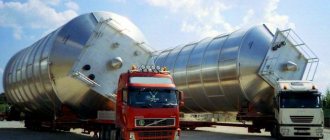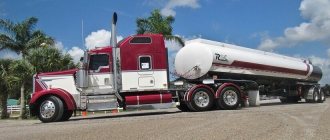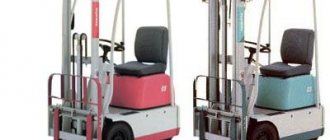Dangerous goods
- these are substances that are potentially harmful to human health or nature, destroy organic substances upon contact with them. The transportation of dangerous goods is strictly regulated by laws, since such accidents involving vehicles carrying dangerous goods cause enormous harm to the environment and other road users.
The conditions and rules for transporting dangerous goods depend primarily on its name and what class it belongs to. Each hazardous substance or group of substances is assigned a special UN number (UN identifier). Using the UN number in the table “List of Dangerous Goods” (Appendix A to ADR), you can find out all the information regarding the transportation of a particular substance/product: labeling and packaging methods, the procedure for placing danger signs on vehicles and containers, choice of vehicle, provisions for transportation and loading and unloading operations, the degree and type of danger posed, and also, importantly, the class of the substance.
There are various dangerous compounds, which are divided into types: poisonous, radioactive, oxidizing, etc. Each species is divided into categories of danger; in total there are 9 classes, divided by level of danger.
Classification of dangerous goods
- Class 1 - Explosives and products;
- Class 2 - Gases;
- Class 3 - Flammable liquids;
- Class 4 - Flammable solids, self-reactive, polymerizing and solid desensitized explosives; substances capable of spontaneous combustion and emitting flammable gases upon contact with water;
- Class 5 - Oxidizing substances, organic peroxides;
- Grade 6 - Toxic and infectious substances;
- Grade 7 - Radioactive materials;
- Class 8 – Corrosive substances;
- Class 9 - Other dangerous substances and products.
Each type of dangerous goods has regulated transportation and storage standards. The standards are prescribed in GOST and the international agreement ADR. In addition to being assigned to a certain class, dangerous goods have their own transport packaging group, which in turn also determines the degree of danger of the cargo.
A clear understanding of what class the cargo belongs to is necessary in order to select the correct containers and packaging, undergo the necessary preparation for transportation, obtain related documentation and conduct special instructions for the driver.
The road transport used to transport exhaust gas must also be appropriately prepared and technically equipped. Along with some special conditions specified for individual substances and products, general requirements also apply when transporting dangerous goods. First of all, transportation of dangerous goods is possible if the vehicle is authorized to transport them, and the driver has undergone special ADR training. It should be borne in mind that a driver with a continuous three-year experience in driving vehicles of the corresponding category can undergo training and obtain an ADR certificate.
In the case of transportation of high-risk cargo, in addition to the vehicle approval and driver’s ADR certificate, a special permit is also required. This rule applies to both international and domestic Russian traffic. Rostransnadzor is responsible for issuing a special permit if the vehicle’s route must pass along federal highways or through the territory of two or more regions.
Also important are the requirements for container labeling and the designation of vehicles. First of all, as noted, the vehicle must be approved for the transport of dangerous goods. It receives such a certificate after a technical inspection designed to check the condition of the vehicle (trailer, container, tank, etc.) and its compliance with safety requirements. The permit is valid only for a year, after the expiration of the period it is necessary to undergo the inspection again. During transportation, the vehicle must be marked so that it can be immediately understood that it is carrying dangerous cargo, and it can be determined exactly what kind of cargo it is carrying and what danger this cargo poses. For this purpose, special orange plates are used, made of resistant and durable material that can withstand adverse atmospheric conditions, not burn in a fire, being in it for at least 15 minutes, and preserve the inscriptions placed on it.
In addition to the plates, the vehicle must have an information board in the shape of a diamond with the symbol/number of the cargo class or subclass. However, it is not required if the danger sign placed on transported containers, tank containers and portable containers is clearly visible and legible.
The outer container in which the cargo is packaged also requires special marking; legible and durable markings must be applied to it.
Documents required when transporting dangerous goods
Transportation of dangerous goods must be accompanied by the following documents:
1) Transport or waybill
, where the following information must be indicated: UN identification code (UN code), shipping name of the cargo, hazard class number, packing group, total quantity of dangerous cargo and, if any, tunnel restriction code.
In addition, the transport document may indicate additional information: in accordance with which clause the ADR is being transported, the value of the control and emergency temperature, the name or symbol of each radionuclide, etc. The need for additional records depends on the class and name of the transported cargo and the requirements that are presented to him (they are all listed in the text of ADR).
2)
The transportation of dangerous goods must be accompanied by
written instructions
: they are drawn up in case of an emergency and describe all the necessary measures that the driver must take if an accident occurs, etc. In addition to listing these measures, the instructions also provide general reminders about the threat posed by each class of dangerous goods and how to protect yourself in each individual case. It also contains a list of personal and general protective equipment in the car.
3)Permit to transport dangerous goods
(with approval of the route), a certificate of approval of the vehicle for the carriage of dangerous goods and an ADR certificate on the appropriate training of the driver transporting dangerous goods.
Depending on the type of cargo, you may also need a substance passport (or safety data sheet for chemical products) and certificates - fire, radiation control, etc.
Transportation of hazard class 2 (gases).
Class 2. Gases.
Oxygen, Propane, Nitrogen, Chlorine , Ammonia , Helium , Carbon dioxide.
Our company transports gas in cylinders and on specialized vehicles - gas carriers (ammonia, oxygen, helium and others) throughout Russia.
Transportation of goods of hazard class 2 is regulated by clause 6.2. Rules for the transportation of dangerous goods by road. The Class 2 title covers pure gases, mixtures of one or more gases with one or more other substances and articles containing such substances.
A gas is a substance that:
- at 50°C has a vapor pressure of more than 300 kPa (3 bar);
- completely gaseous at 20°C and normal pressure 101.3 kPa.
But there are exceptions, UN No. 1052 HYDROGEN FLUORIDE, ANHYDROUS is classified in Class 8.
Pure gas may contain other components that are by-products of its production or added to maintain the stability of the substance, provided that the level of their content does not change the classification and conditions of its transport, such as filling factor, filling force, test force.
Class 2 are divided into gases:
- Compressed - which, when loaded under pressure for transport, is completely gaseous at -50 degrees; This category includes all gases with a critical temperature of -50 degrees or less.
- Liquefied – which, when loaded under pressure for delivery, is partially liquid above -50 degrees. It is necessary to distinguish:
high-pressure liquefied – with a critical temperature above -50 degrees and not above +65 degrees;
liquefied low pressure - with a critical temperature above +65 degrees.
- Refrigerated liquefied - which, when loaded under pressure for delivery, is partially liquid due to its low temperature.
- Dissolved - when loaded under pressure for transportation, dissolved in a liquid solvent.
- Aerosol sprays and small containers containing gas (gas cartridges).
- Other products containing gas.
- Non-pressurized gases subject to special requirements.
Substances and products (except aerosols) of class 2 belong to one of the following groups depending on their hazardous properties:
A - asphyxiants , which are non-oxidizing, flammable and non-toxic and which dissolve or replace the oxygen normally contained in the atmosphere.
O is an oxidizing agent that can, usually through the release of oxygen, cause or support the combustion of other materials to a greater extent than air.
F - flammable, which at 20° and normal pressure 101.3 kPa:
- flammable in a mixture with air at a concentration of no more than 13% by volume;
- have a range of concentration flammability limits in a mixture with air of at least 12 percentage points, regardless of the value of the lower concentration flammability limit.
T - toxic:
- are known to be so toxic or corrosive to humans that they pose a health hazard;
- are considered poisonous or corrosive to humans.
Gases that are characterized by hazardous properties inherent in more than one group in accordance with the criteria, designated T, prevail in degree of danger over all other groups. Those designated F take precedence over groups designated A or O.
Division 2.1 : flammable (indicated by a capital F)
Division 2.2: non-flammable, non-toxic (indicated by capital letters A or O)
Division 2.3 : Toxic (designated with a capital T, i.e. T, TF, TC, TO, TFC and TOC).
Corrosive gases are considered toxic and are therefore classified as TC, TFC or TOC.
Corrosive - Those that fully meet the toxicity criteria due to their corrosive properties must be classified as toxic with an additional corrosive hazard.
A mixture of gases considered toxic due to combined corrosive and toxic effects poses an additional corrosive hazard if it is known to be corrosive to the skin, eyes or mucous membranes.
Aerosols - (UN No. 1950) are classified according to their hazardous properties. The classification depends on the nature of the contents of the aerosol dispenser.
The following substances and mixtures are not allowed for transportation:
- UN No. 2186 HYDROGEN CHLORIDE, REFRIGERATED, LIQUID;
- UN No. 2421 NITROGEN TRIOXIDE;
- UN No. 2455 METHYL NITRITE;
- assigned to classification codes 3A, 3O or 3F;
- dissolved gases which cannot be classified as UN No. 1001, 2073 or 3318;
- aerosols that use gases that are toxic or pyrophoric as propellants;
- aerosols whose contents meet the packing group I criteria for toxicity or corrosivity;
- small containers containing gases that are highly toxic or pyrophoric.
Loading and unloading dangerous cargo
Loading of dangerous cargo is carried out in accordance with all the necessary requirements for each class and name of the substance/product and described in detail in the text of ADR. At the same time, regardless of the type of dangerous cargo, the packaging with it should in no case be thrown or subjected to impacts; they must be properly secured, and if we are talking about transporting cargo in tanks, then when they are filled, the so-called “underfilling” to prevent leakage and deformation of the container as a result of liquid expansion.
The vehicle engine must be turned off during loading and unloading operations (except for those cases when it is used to start pumps and other mechanisms with the help of which loading/unloading is carried out).
Under no circumstances should you smoke or eat near dangerous goods. During loading, the use of fuel heating devices is also prohibited.
TRANSPORTATION OF UREA (TRANSPORTATION OF UREA)
Cars are painted in special colors, and on the sides there are images indicating danger. Flammable compounds are painted orange; spontaneously combustible elements must be transported in vehicles that are white on top and red on the bottom.
The main regulatory documents that are followed when transporting dangerous goods:
- Guide No. 3112199-0199-96 , which shows how to organize the transportation of dangerous goods by vehicle. Approved on 02/08/1996 by the Department of Motor Transport of Russia.
- Order No. 73 dated 08.08.95 - Rules for the transportation of exhaust gases (edited 14.10.99).
- General Rules for the transportation of road cargo , approved by Government Decree No. 272 of 04/15/11
- ADR (ADR) is an international agreement for the road transport of dangerous goods in European countries.
- Safety precautions and its measures that must be observed are prescribed in the Government Decree of the Russian Federation No. 372 of 04/23/94, which was revised on 03/16/97 and is still valid.
- Security measures are also prescribed in Order of the Ministry of Transport of Russia No. 47 dated 07/06/94
Car coolers contain ethylene glycol, a toxic substance, classified as dangerous goods of class 6 (subclass 6.1) according to the ADR classification. This type of coolant is assigned UN number 2810, classification code 6612, and packing group II.
conclusions
So, what is required in order to efficiently transport dangerous cargo and prevent its harmful effects on people, animals and the environment?
The main thing is to know the shipping name of the substance/product and its UN number. Using this number, it is easy to determine the class of cargo, its transport category, packaging group, the danger it poses, requirements for packaging, loading/unloading, transportation, selection of a vehicle and its designation, and compatibility with other dangerous goods.
TRANSPORTATION OF CORROSION INHIBITORS
We have high quality, low tariffs and VAT refund. Cargo transportation of dangerous goods. Classification (hazard classes).
Fuel and lubricants are “fuels and lubricants”, various products made from oil. These goods belong to the industrial variety, so their sales are carried out exclusively by specialized companies.
At the same time, ADR allows the transportation of these dangerous substances to private individuals for personal use and for resale, but with a limited quantity and only in certain containers.
Fuel and lubricants are “fuels and lubricants”, various products made from oil. These goods belong to the industrial variety, so their sales are carried out exclusively by specialized companies.
Drivers most often become interested in the rules for transporting such dangerous goods when they need to transport gasoline or diesel fuel (diesel fuel) in the trunk.
All types of gunpowder are easily ignited by an impact or spark, so they are placed in metal boxes and then in a wooden crate.
Additive compatibility affects the ability to mix different coolants. Different manufacturers use different substances. In addition, the packages they offer may differ in the quantity and composition of the substances used. Some resort to the help of inorganic compounds (phosphate, amine, etc. inhibitors). Others use imported new generation chemical compounds.
But private car owners should know that, in order to comply with safety precautions, coolant can only be transported in special metal barrels or cans with hermetically sealed lids. Covers are usually sealed during transportation. Moreover, empty cans and barrels that previously contained antifreeze must also be sealed.
Delivery of ammunition in large quantities requires paramilitary security and is carried out under contracts with military-industrial complex organizations. Ammunition is divided into:
- incendiary influence
- causing smoke
- tear
- causing poisoning
- illuminating
- practical
- test
How to cool the fluid in the engine? Just. Use ready-to-use concentrates or antifreeze. Before using them, it is important to dilute them with distilled water, while maintaining the proportions.
Ask our experts and you will receive a competent answer within 1-2 business days. For users who have paid for access to the Knowledge Bank, the answer will be free.
Secondly. According to Order of the Ministry of Transport No. 179, special permits are required only for the transportation of high-risk cargo, which are listed in section 1.10.5 of the 2011 ADR. UN2810 dangerous goods can be either packing group I, packing group II or packing group III. In this article, we covered what fuels and lubricants are, deciphered the abbreviation and told us what these or other products are used for.
To transport coolants, specialized railway tanks with top discharge, tank trucks and metal barrels specified in clause 2.4.1 are used.
Transportation of coolants packed in barrels and consumer packaging in boxes is carried out in transport packages in accordance with the requirements of GOST 26663.
Hay is dangerous cargo
Antifreeze is a Russian antifreeze class G11 (mineral). Antifreezes are coolants based on ethylene glycol, used in the car system to cool the engine and protect against overheating.
Car coolers contain ethylene glycol, a toxic substance, classified as dangerous goods of class 6 (subclass 6.1) according to the ADR classification. This type of coolant is assigned UN number 2810, classification code 6612, and packing group II.
The manufacturer is obliged to include information about the composition of the product, hazard information, warning labels and pictograms on consumer packaging and original packaging.
Rules for transporting antifreeze by road
Attention! Coolants (antifreeze) based on ethylene glycol are transported by road outside the manufacturer's plant as dangerous goods. Antifreeze delivery is required - contact a transport company that will transport the coolant in compliance with the requirements and recommendations of ADR.
guarantees compliance with the rules for transporting hazardous products:
- Availability of a valid (at least 1 month before expiration) ADR certificate for the tractor, trailer and driver.
- Marking of rolling stock with special danger signs.
- Coordination of the route and registration of special permits for the movement of exhaust gas on public roads.
- We will help you prepare a safety data sheet for the product (MSDS) and fill out shipping documents.
We accept applications for domestic and international transportation of antifreeze in large wholesale and small quantities.
We draw the attention of customers that limited quantities of coolant are allowed to be transported by road without an ADR certificate:
- in containers with a capacity of no more than 5 liters;
- total quantity up to 1000l;
- if there are danger signs on the car;
- by a certified driver.
We will help you send a commercial shipment of antifreeze by rail:
- in bulk in railway tanks;
- packaged in containers - by wagon or container lot.
You can order the transportation of antifreeze in barrels, canisters or in bulk, and request a calculation of the cost of transport services through the application form, online chat or by phone.
- Article 155 LC
Article 155 LC RF. Payment for residential premises and utilities. Housing Code of the Russian Federation… - Article 69 of the Housing Code of the Russian Federation
Comments on Art. 69 of the Housing Code of the Russian Federation Article 69 of the Housing Code of the Russian Federation. Rights and obligations of the employer's family members...
nec-it.ru
What is the fine for transporting dangerous goods without a flashing light?
- for a legal entity (carrier organization) - a fine of 400,000 to 500,000 rubles.
- for the driver - a fine of 2000 to 2500 rubles or deprivation of rights for a period of 4-6 months;
- for an official - a fine from 15,000 to 20,000 rubles;
Violation of the rules for the transportation of dangerous goods, except for the cases provided for in Part 1 of this article, entails:
- for a legal entity (carrier organization) - a fine from 150,000 to 250,000
- for an official - a fine from 5,000 to 10,000 rubles;
- for the driver - a fine from 1000 to 1500 rubles;
What will be the fine if there are no documents for the transportation of dangerous goods?
- The transport organization that deals with this transportation – from 400 thousand rubles to 500 thousand rubles.
- If the driver, when checked on the road by traffic police inspectors, does not have a permit for admission and compliance of the vehicle itself for the transportation of exhaust gas, then the penalties are similar:
- The official who is responsible for the dispatch and delivery of cargo - from 15 thousand rubles to 20 thousand rubles.
- transporting driver - from 2 thousand rubles to 2 thousand 500 rubles;
- official - from 15 thousand rubles to 20 thousand rubles.
- transport organization - from 400 thousand rubles to 500 thousand rubles;
We recommend reading: The behavior of the ex-wife wants to return
Experts recommend: to protect against the listed penalties, the transport company must not violate the Rules and promptly prepare all permitting documents for the transportation of dangerous goods by contacting the appropriate authorities.
Then it can be considered as transportation of non-hazardous cargo.











